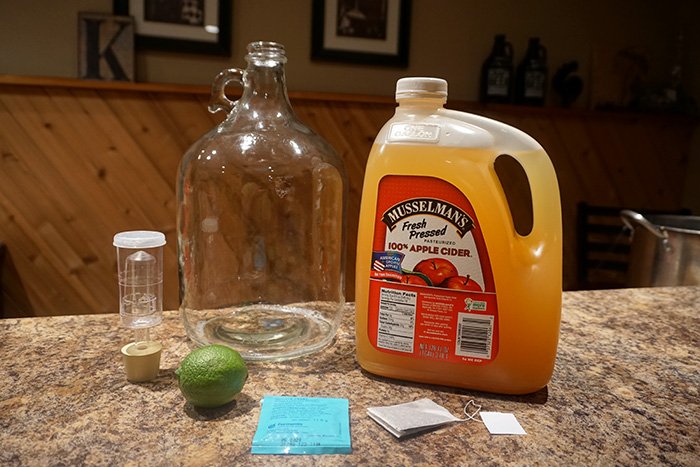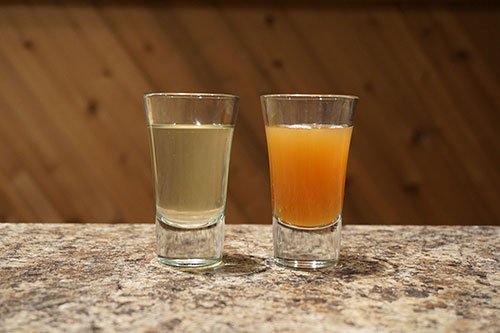Personally, one thing I don’t like to do is clean and sanitize dozens of bottles. It can be a pain to clean old bottles and filling them can get messy. On top of that, getting the carbonation just right can also be tricky.
So, I invested in kegging equipment for packaging the bulk of my ciders and other homebrew creations and it changed the hobby for me. Being able to keg beverages and force carbonate has really sped up the process for me and made it more enjoyable.
If I want to bottle some cider, I can draw it off the tap and cap it. Perfect every time!
Kegging cider allows me to package in bulk, adjust carbonation, and even adjust flavor after if I would like.
The benefits are well worth the investment!
Equipment Needed to Keg Cider
So let’s go over the basic equipment needed to start kegging cider or other home brewing creations.
Basic Setup:
- Keg
- CO2 Tank
- Tap
- Connection Fittings/Hoses




Cheap and Easy Kegs:
The first and most obvious is the keg itself. The 5 gallon Cornelius keg, aka corny keg, is a popular choice for the home cider maker as the size is very convenient.
Kegs can also be found in other sizes such as 2, 2.5, and 3 gallons. These little ones are great if you don’t have a dedicated refrigerator that will fit a 5 gallon keg.
Corny kegs come with two fittings on top, a gas inlet for CO2, and a liquid out for dispensing the goods.
While ‘inlet and outlet’ are obvious standards, there are also two different styles of fittings that can be found on kegs. These are either Ball Lock or Pin Lock. They both work well, but the fittings are not interchangeable with the hose connectors so keep that in mind. But, pin lock and ball lock fittings on the keg itself can be changed, so they are flexible.
I personally have both now but the first ones I bought were Pin Lock kegs because I found them for super cheap on Amazon and I couldn’t pass up the deal!
CO2 Tank and Regulator:
The next important piece of equipment which may be foreign if you are new to kegging cider is a CO2 tank and regulator. This is used for pressurizing the keg, AKA carbonating the cider.
The CO2 tank holds highly pressurized CO2 that is used to carbonate the cider while the regulator is used to, well, regulate. The regulator allows you to set the pressure that you would like to send to your keg. This pressure will determine the carbonation level which I talk about in this post.
Tanks and regulators can be found at your local HBS or bought online.
I found an empty tank and regulator on craigslist for $30 and I exchange the tank at my local homebrew shop when I need a refill, pretty simple!
Taps for Dispensing:
The tap can be as simple or as elaborate as you choose.
The type of tap you choose, and you will probably have a few, will depend on your setup and style of beverage.
If you are serving from inside a fridge or on the go, you may want a simple picnic tap. They are a few bucks and get the job done.
If you have a kegerator or bar setup, there are a wide variety of mounted taps in all budgets.
Hoses to Connect the Keg System:
The last pieces of hardware you will need for your kegging setup are the hoses.
Hoses connect the Co2 tank to the keg and the keg to the tap. Typically this hose is 3/16” food grade vinyl and is referred to as beer line.
The Co2 regulator to keg fitting hose can be any length you would like, having extra makes life easier.
But, the hose that connects the liquid out fitting on the keg to the serving tap should be measured and cut to the length that best suits the beverage style, and pressure you will be serving at.
To put it simply, if the serving hose is too short and the carbonation level is too high, you will only be blowing bubbles. If the hose is too long, the pour will be slow and can also be foamy.
Don’t worry though, it’s easy to figure out.
Pressures to Make it Bubbly and Flow:
Getting everything dialed in will take some practice, but the main factors to look at are the level of carbonation in the cider and the serving pressure.
When kegging most ciders, I like to carbonate my kegs around 15psi at 36F to achieve approximately 3 volumes of Co2 carbonation. This is higher than most beers, but because cider does not have the proteins that beer does, it will foam less and can handle more carbonation.
Here is a forced carbonation chart to help you find your temperatures and pressures.
I am able to serve a 3 volume CO2 cider at 15psi with about 7 feet of hose in my kegerator and I have great results.
My picnic tap is shorter and it still pours ok, but probably a little fast. In this case, I lower my serving pressure (regulator pressure) to reduce the “push” and it will serve nicely.
Keep in mind, if you lower the Co2 pressure and serve for a long time, the cider will eventually equalize with the new keg pressure and become less carbonated.
Problem Solved
Hopefully, this had demystified the equipment needed to keg cider and you can see how beneficial it can be. Once you start kegging, you will never go back! It really is the simplest way to carbonate and serve cider, especially if you desire a semisweet or back sweetened cider without using additives.
If you want to learn how to fill and carbonate kegs, check out my post on how to keg hard cider.
Don’t forget to leave a comment below to let me know what you think or what you want me to write about!



